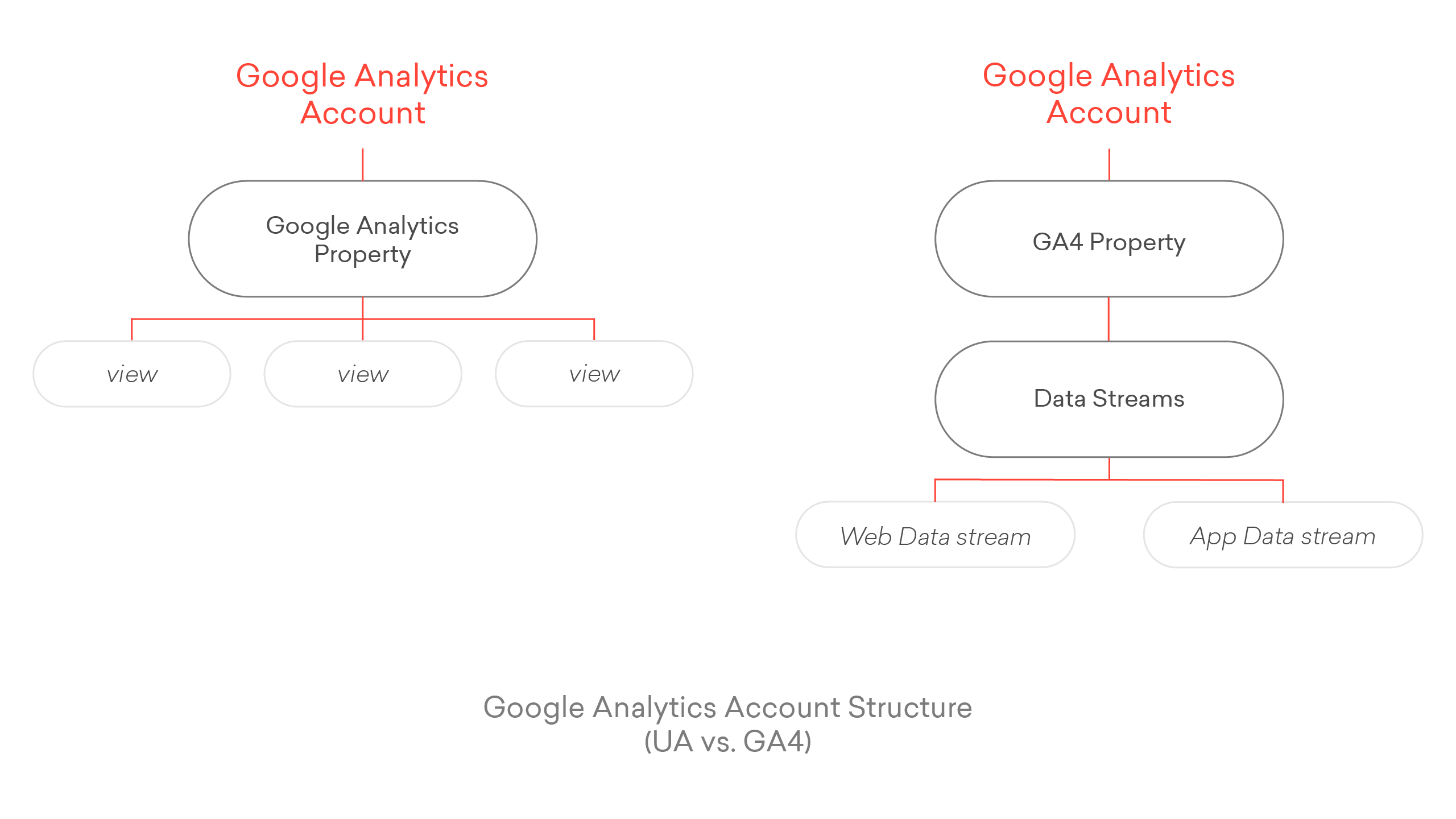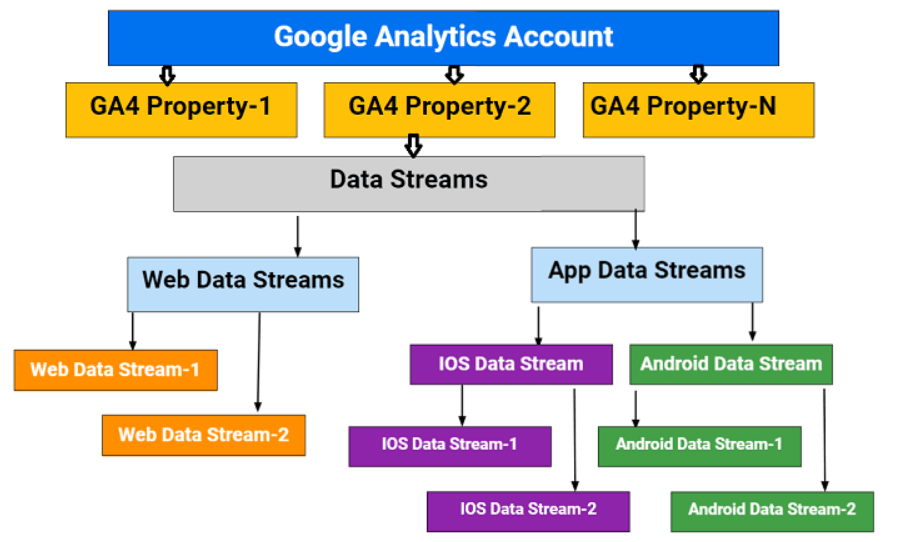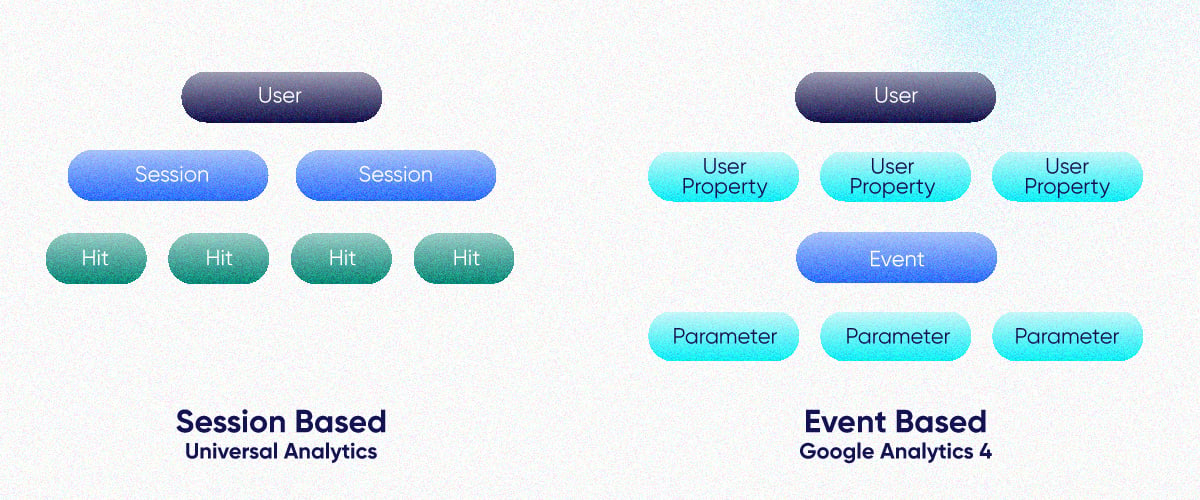In recent years, the scale of the business market that utilizes the Internet environment continues to expand. In such Internet businesses, understanding user behavior on websites and apps, and collecting and analyzing detailed information is essential for expanding business and services.
Google Analytics 4 property is an innovative tool that can help solve such cases. Analytics is now being widely used by many companies and marketers, and after numerous updates, Google Analytics 4 properties were newly released in 2020 as an even more innovative tool.
In this article, we will explain what is Google Analytics 4 property? Starting with that, we will introduce its features and how to actually set it up.
What is Google Analytics 4?
Google Analytics 4 is an innovative solution provided by Google that allows you to understand user behavior on websites and measure various data. Officially, it is also called “Google Analytics Property 4” and abbreviated as “GA4”.
The Google Analytics service was launched in 2005, and Google Analytics 4 can be said to be a new version of Google Analytics that has been significantly upgraded from the previous type.
Before Google Analytics 4 was officially released, it already existed in 2019 as an “app + web property”, but it did not target only a limited number of users who had both an app and a web business. In 2020, the name was officially changed to “Google Analytics 4 Properties” to clearly indicate that it is targeted at all businesses.
Let’s understand that Google Analytics 4 property (GA4) has a major feature that allows data processing for both websites and apps. Until now, there was a solution called “Universal Analytics” that measures websites, and “Google Analytics for Firebase” as an independent solution that only targets app measurement, but these have been integrated and are now called “Google Analytics 4 Properties”. ”.
Google Analytics 4 properties are equipped with many new features for all users of analytics, without being influenced by limited data processing such as website-only data processing or app-only data processing. It is being done.
Google Analytics 4 properties can flexibly respond to the ever-changing business scale and diversification of business formats, and are designed to enable detailed data measurement across devices and platforms. For this reason, by utilizing Google Analytics 4 properties, it is possible to develop a measurement strategy that adapts to the digital environment, which changes at an incredible speed every day. In addition, by utilizing the advanced machine learning provided, it is possible to make highly accurate predictions that are useful for business and marketing, contributing to the further expansion of business and service areas.

Main features of Google Analytics 4 properties
From here, we will introduce the typical features of Google Analytics 4 properties.

Measurement across web and apps
By using Google Analytics 4, it is possible to “measure, integrate, and deduplicate” user interactions on the web and within apps across devices and platforms. In this way, flexible responses tailored to your business can help you understand highly relevant customer journeys in a timely manner, which plays a major role for your business.
In fact, Google Analytics 4 has a new feature called “Data Stream”. By selecting this data stream, data streams will be managed by tabs of “Web”, “iOS”, and “Android”.
By configuring the settings below, detailed data will be collected in each data stream of “Web”, “iOS”, and “Android”, and it will be possible to integrate and process data from both websites and apps. .
- To manage “web” data, add a new measurement ID to your website using either “Google Tag Manager (GTM)” or “Global Site Tag (gtag.js)”.
- For “iOS/Android” data management, “Firebase SDK” is linked with Google Analytics4 properties.
User interactions across multiple devices and platforms can be measured as the same user signal.

Machine learning analysis prediction
Google Analytics 4 properties are equipped with “prediction indicators” that perform analysis and predictions from data obtained using Google’s machine learning.
Forecasting can predict the “possibility of a site access user to purchase” and “the possibility of a site access user to leave.” In addition, regarding “revenue prediction”, you can also predict “the total revenue that will be obtained from
that users who have performed operations in the past 28 days will achieve in the next 28 days.”
In this way, by leveraging Google’s machine learning, it is possible to discover insights automatically and smoothly, making it easier to extract maximum value from various user data.
Data collection with an emphasis on privacy
In recent years, from the perspective of privacy protection, when users around the world use the Internet environment, the rise in expectations for privacy, the establishment of new regulations in various parts of the world, and the reduction of browser support for
cookies
have become a hot topic. It has an impact on many different aspects. For this reason, companies and marketers that utilize the Internet environment to provide business and services must constantly adapt to changes in the way they measure user interactions with their businesses.
Google Analytics 4 properties support businesses and marketers with a durable means to reliably measure user interactions with the businesses and services they offer, while addressing growing user expectations for privacy protection. Masu. From a global perspective, there is a growing movement to phase out third-party cookies, but Google Analytics 4 properties are designed to comply with such data regulations and are compliant with the California Consumer Privacy Act (CCPA). It is a tool that complies with data regulations such as ” and GDPR (EU General Data Protection Regulation).
You can control the data you collect by using features such as anonymizing IP addresses, disabling data collection, and setting data retention periods.
In addition, due to the influence of privacy protection, the Internet market is subject to various changes that significantly limit the number of signals sent by users. Companies and marketers who utilize the Internet environment to develop businesses and services are recognizing the importance of advanced automation and machine learning in order to provide advertisements that are highly relevant to users and perform highly accurate measurements. It’s becoming more and more sexual. By using collection models trained on measurable data, data modeling that addresses data regulations while emphasizing global privacy expectations reduces user signals that are typically limited. It also leads to supplementing.

What is the ID space used in Google Analytics 4 properties?
With Google Analytics 4 properties, it is now possible to use multiple user identification information, such as “Google signals, device IDs, and IDs assigned to website login users,” in order to understand the behavior of website users. Masu.
Such groups are called “ID spaces,” and their existence value has been established.
From here, we will briefly introduce three types of identification information that can actually be used in the ID space.

User ID
By creating unique user IDs for your website’s logged-in users, you can leverage that ID data to accurately measure user journeys within your website across multiple devices. Remember that to enable the User ID feature, you need to consistently assign a corresponding ID to your users and send this ID along with your data to your Google Analytics 4 property.

Google signals
Google signals are used as identifying information based on data collected from users who are actually logged in to Google. When you enable Google Signals, the Google Analytics 4 property associates event data collected from users visiting your website with the Google account of the web logged-in user who has consented to sharing the information.
Also, enabling Google signals doesn’t require any complicated steps. Keep in mind that you can enable signals with a few simple steps, and you don’t need to change any website or app settings to take advantage of this feature.

device ID
Google Analytics 4 properties can automatically use the device ID used by website users as the ID space. The device ID actually obtained from the website is obtained from the web user’s browser. The device ID obtained from the app is obtained from the app instance ID. There are no special settings required to use the device ID with Google Analytics 4 properties.
As mentioned above, Google Analytics 4 properties make it possible to process data appropriately by using available ID spaces such as “Google signals, device IDs, and IDs assigned to website login users.” I did.
Google Analytics 4 properties search for user IDs using the data collected by the user ID you created. Next, we search for Google signals, and if there is no matching data in either, we finally use the device ID. It will then be possible to filter a large number of data associated with the same ID and visualize it as a single user behavior path, expanding the scope of its use as valuable collected data.

Reports within the Google Analytics 4 property use the identifiers of web users generated by these ID spaces, which eliminates duplication of users and provides a unified view of the relationship between the business you are developing and the users. You can pinpoint the entire picture.

Google Analytics 4 property and data stream settings
Step 1. Create an Analytics account
Access Google Analytics. Create a new account or log into your existing account and open your account settings.
Step 2. Create a Google Analytics 4 property From the management screen, select Create property and click the button.
Let’s enter your business information into the new property.
*New properties created in Analytics will be GA4 properties by default.
Step 3. Select the data stream platform to create the data stream from “Web, iOS, Android” and enter the information of the app or website.
When you create a web data stream, you will see an option called Enhanced Measurement.
Turn on this option to automatically collect page views, scrolls, link clicks leaving your domain, site searches, and other common user events. You can turn Measurement Enhancements on or off at any time.
Step 4. Start collecting data In order to collect various data on the web using the created Google Analytics 4 property, you need to add an Analytics tag to the site you want to measure.
Add the appropriate tags to your website, keeping in mind that the steps for adding tags will differ depending on whether you are using a CMS, global site tags, or Google Tag Manager. Additionally, when it comes to apps, when you integrate the Firebase SDK into your app, basic app usage data is automatically collected.
summary
In this article, we will explain what is Google Analytics 4 property? From that point on, we introduced its features and how to actually set it up.
Compared to Universal Analytics, the market penetration rate is still low, and there may be many companies and marketers who have not yet started using Google Analytics 4 properties.
The various functions of Google Analytics 4 properties are only in the development stage, and further evolution can be expected with future updates. It is also very important to prepare for a complete migration that may occur in the near future by using Universal Analytics and Google Analytics 4 properties together.
We will continue to closely monitor trends in Google Analytics 4 properties and use them to expand our business and services.

